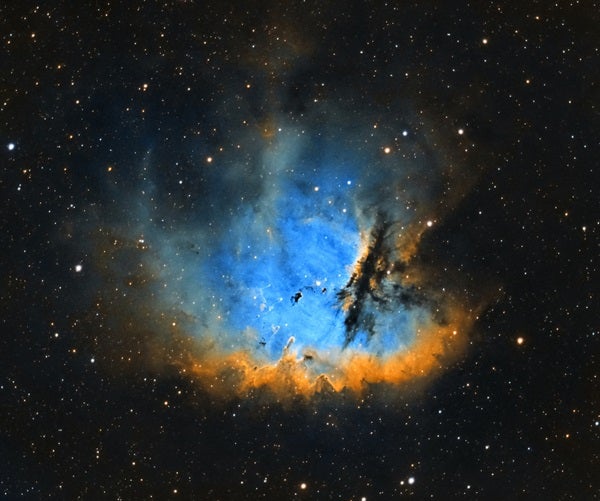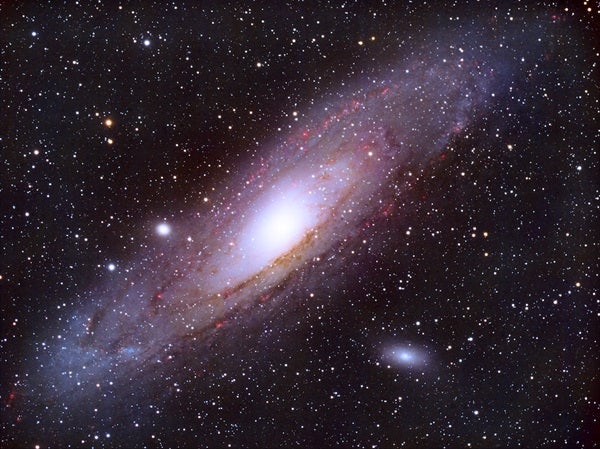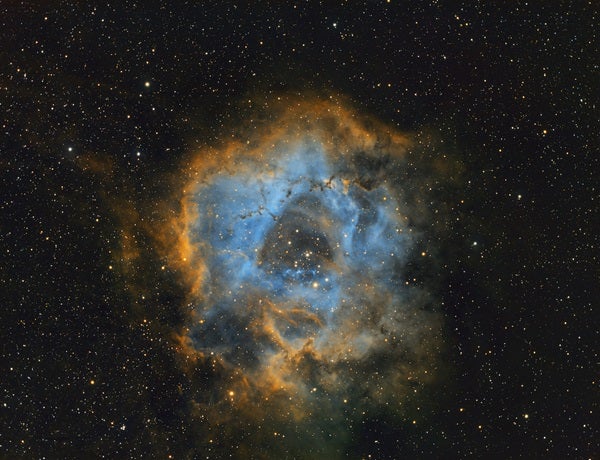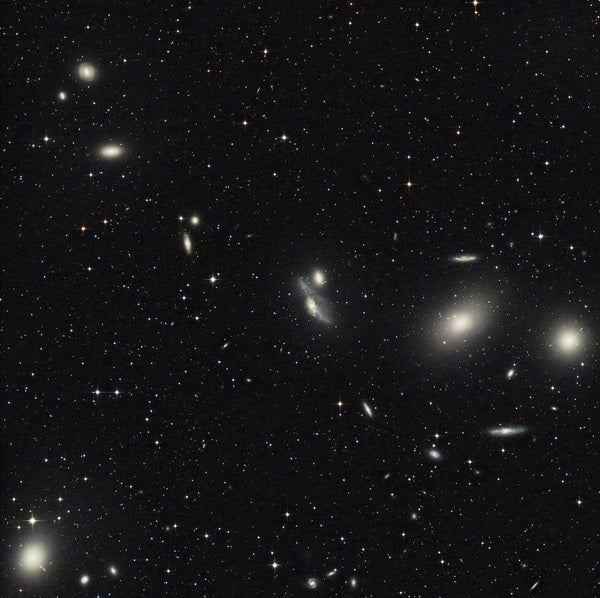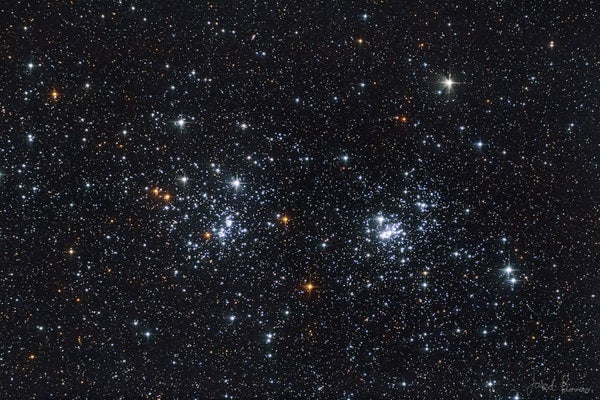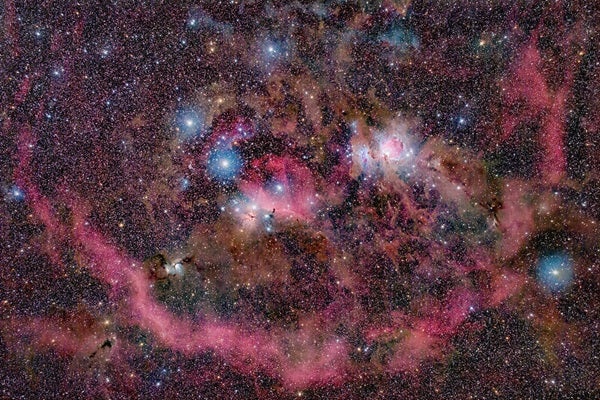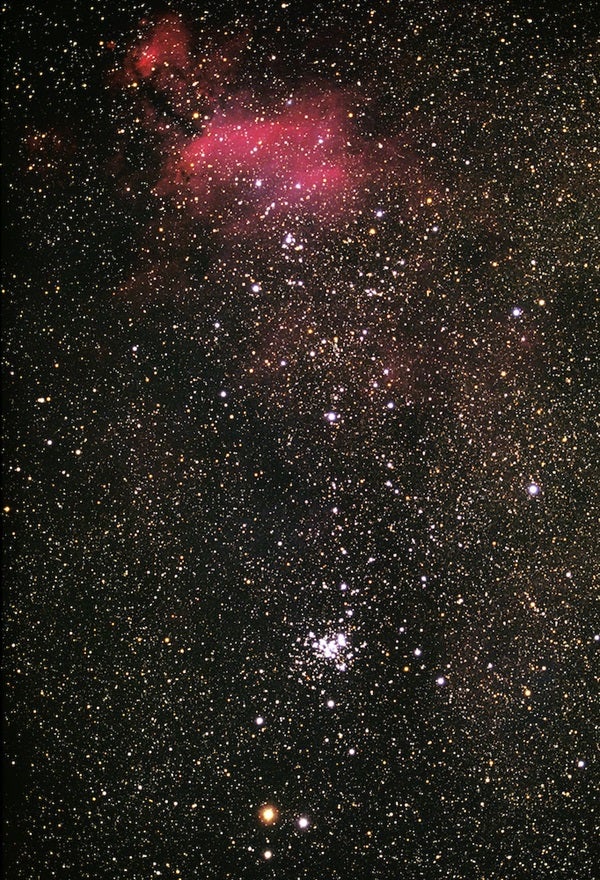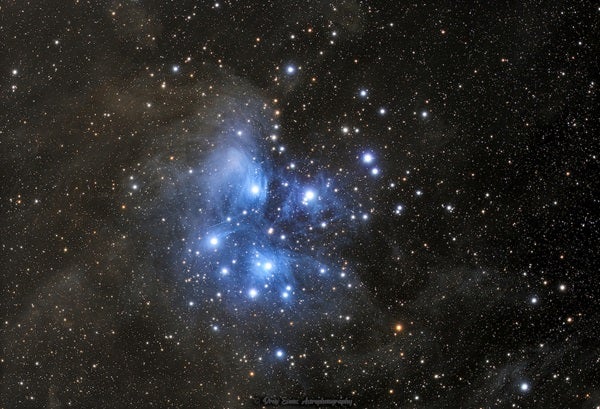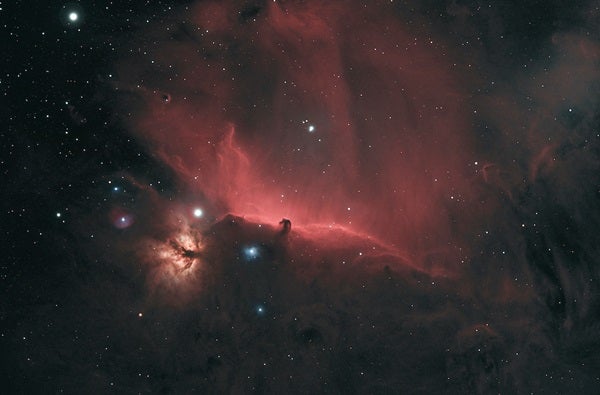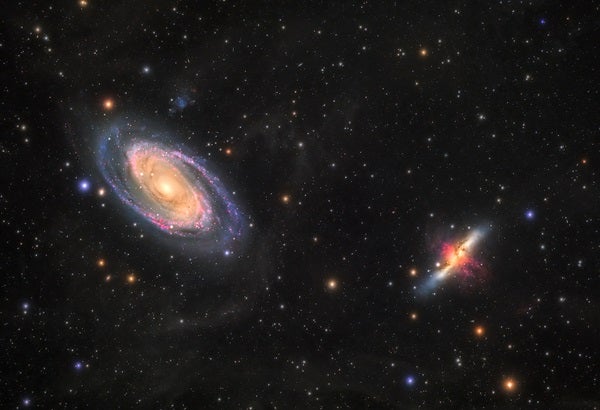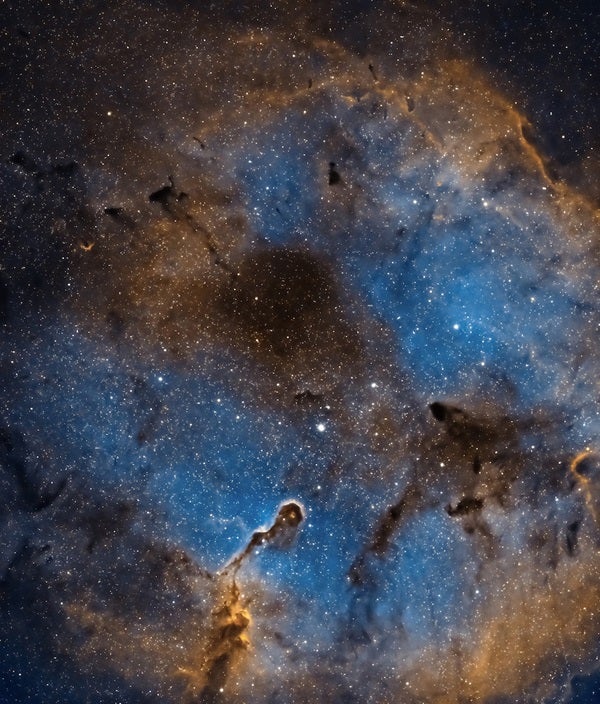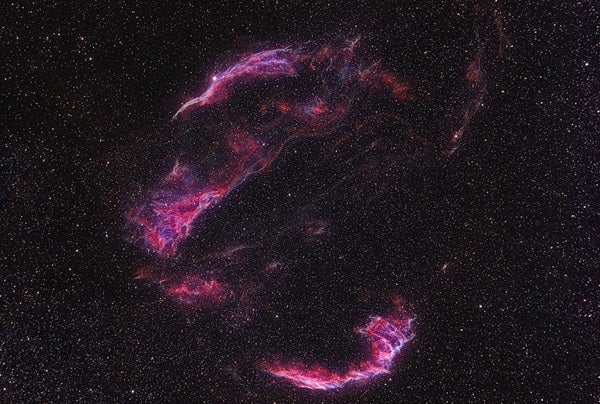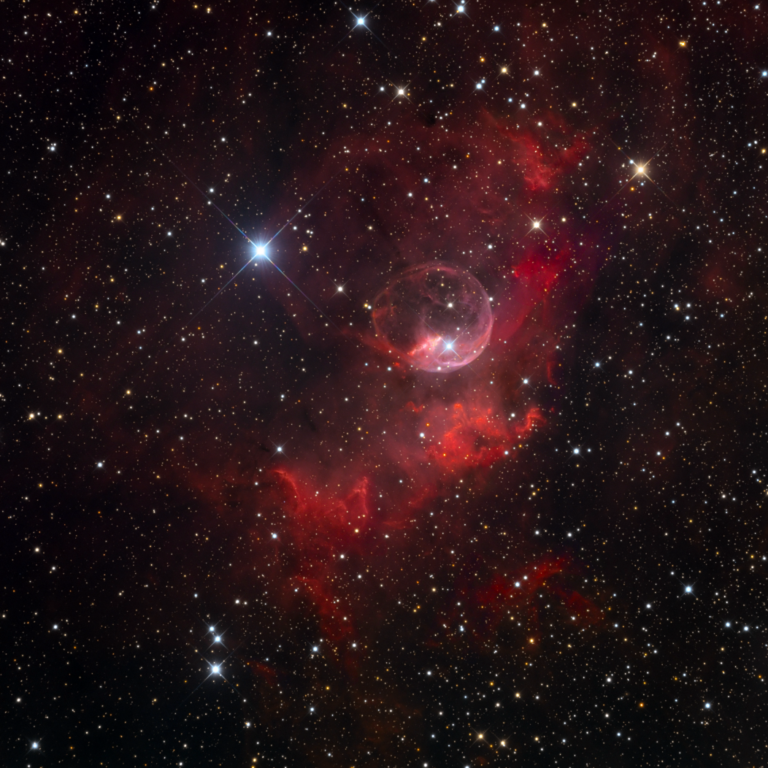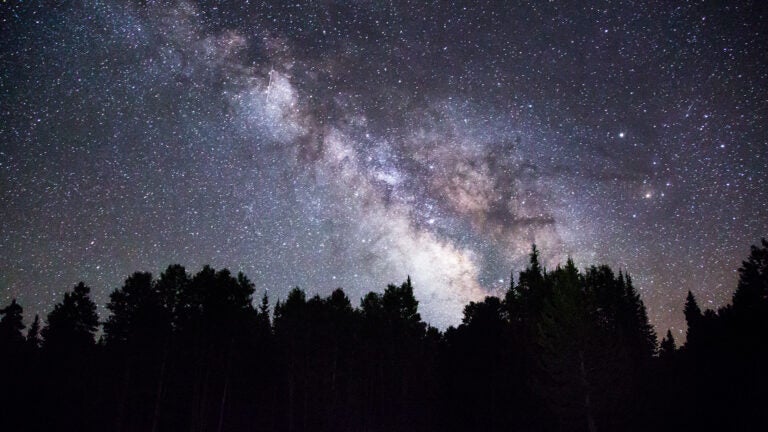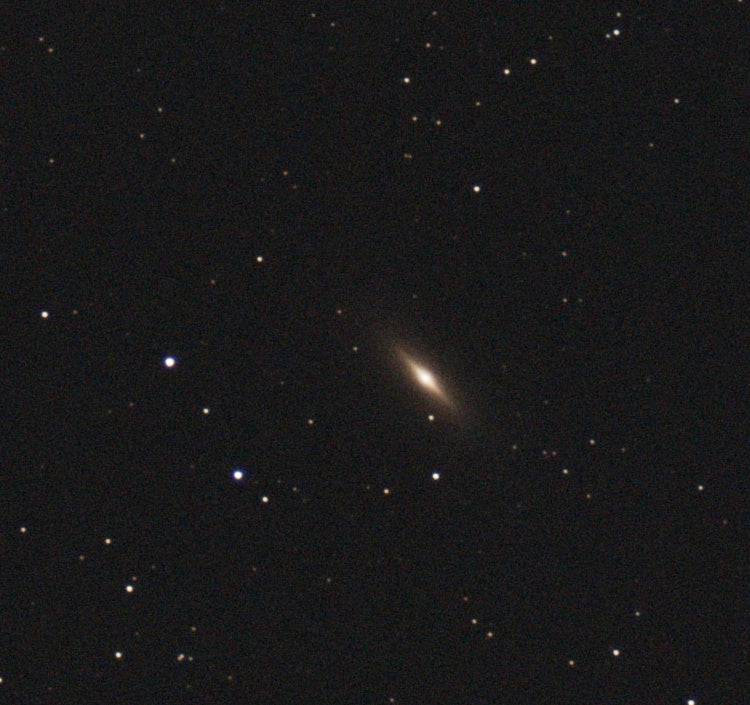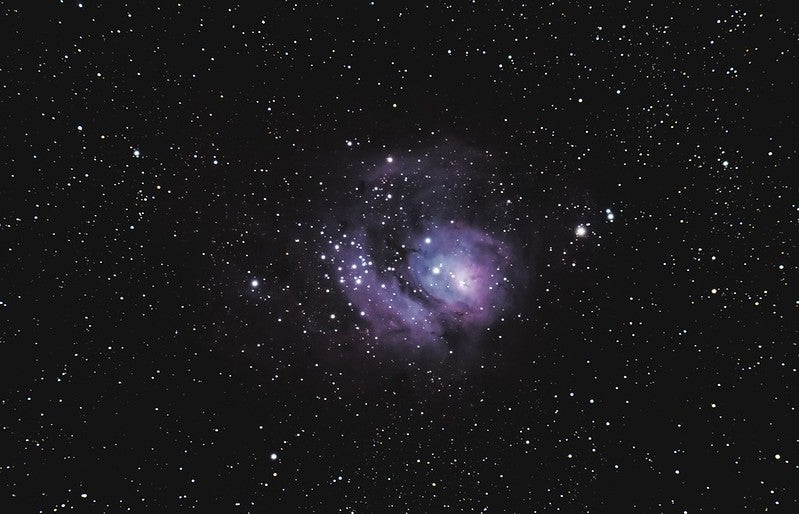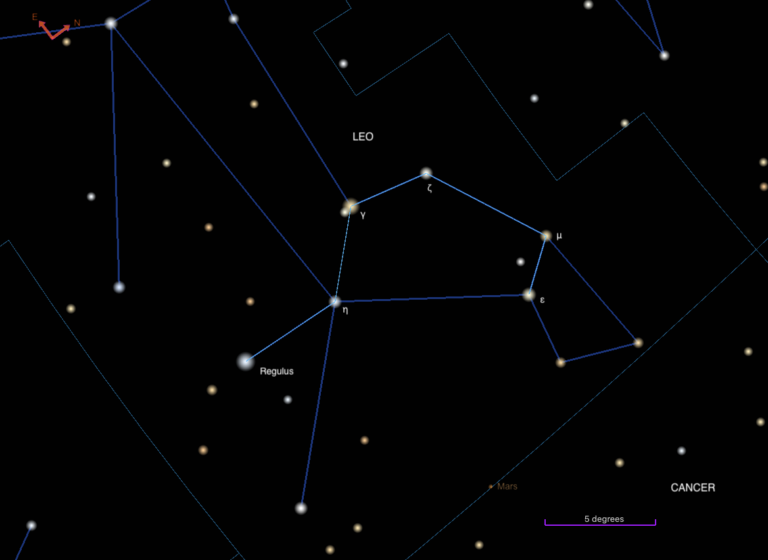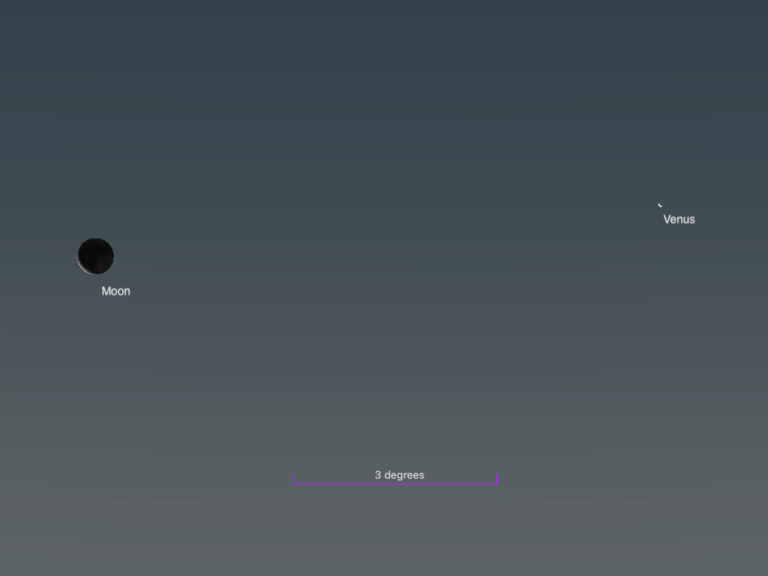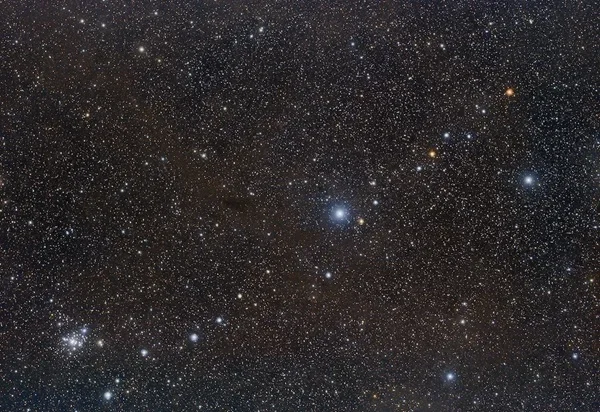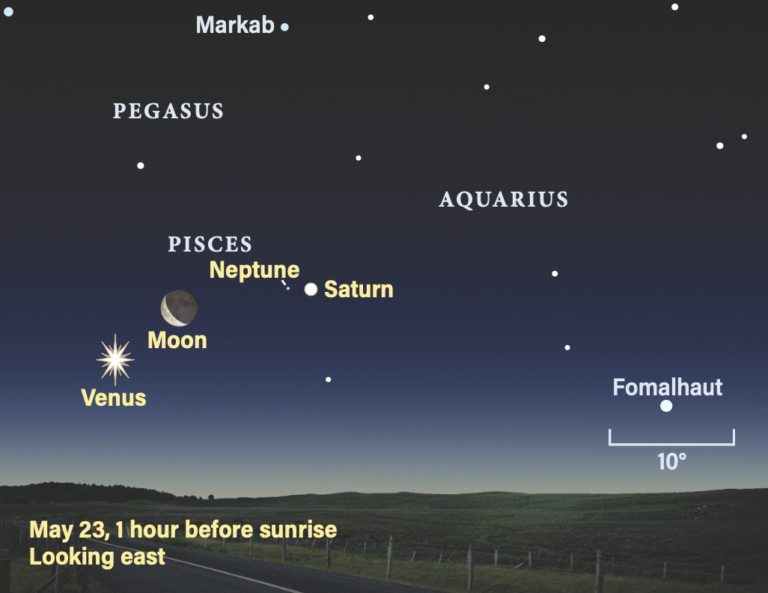Years ago, I heard reports of amateur astronomers glimpsing a huge emission nebula in our galaxy, cataloged as IC 1396. Deep astroimages showed an expansive, complex nebula in Cepheus, about 3° in diameter on the northern side of the brightest visual band of the Milky Way, above Cygnus. Being a huge fanboy of all things that shine with the dim glow of ionized hydrogen and oxygen ions, I had to see it!
Based on years of success observing faint, challenging galaxies, I confidently aimed my telescope towards Cepheus, eagerly anticipating visions of a grand nebulosity. But the best I could manage was the faint impression that something was there. I was sorely disappointed. Frustrated, I dismissed other observers’ written reports as wishful thinking.
As it turned out, the fault was my own. I was using the wrong eyepieces and my telescope was too big for the challenge.
It wasn’t until the fall of 2020 that I routinely started using small, short-focal-length telescopes with some massive, 2″ wide-angle eyepieces. Upon my first try with a particularly wide-angle combination, I achieved my first direct view of IC 1396: a big, round, splotchy glow in the sky.
So how was IC 1396 hidden in plain sight? My error was observing with a scope that had too much focal length and eyepieces with too-narrow apparent fields of view (AFOV). The telescopes and eyepieces I initially employed showed me only a portion of the nebula, rendering it unrecognizable. Essentially, I was trying to discern the subject of a painting using a microscope.
The magic combination of telescope and eyepiece that finally revealed IC 1396 was a modest 3.1-inch f/6 achromatic refractor (500mm focal length), combined with a 35mm eyepiece with an apparent field of view of 68°. The magnification of this rig was 14x, providing me a huge 4.8-degree true field of view. I finally had a wide enough field to see the entire object at one time!
Secrets to ultrawide-angle observing
My mistake is a common one for first-time and experienced observers alike, since it’s easy to be drawn to the best equipment the market has to offer. But with the right equipment (and a little bit of patience) you can easily take an ultrawide-angle tour of the night sky.
You may wonder if binoculars can be used to observe wide-angle targets. Binoculars are wonderful, and in many cases, a good pair will allow you to locate these objects under a dark sky. However, I recommend a wide-angle telescope if possible, as it is far more flexible and usually has better optical quality and performance.
TIP 1: Configure an ultrawide-angle telescope kit
If you want to track down wide-angle wonders, you’ll want a fairly short-focal-length telescope. Why? As evident in my struggle to view IC 1396, these kinds of expansive targets require a low power, or wide-angle, view of the sky. To find the power of your setup, divide the focal length of your scope by the focal length of the eyepiece. As a rule of thumb, to get a low enough power, you will likely need a telescope with less than 1,000mm of focal length.
Your kit also will need a few 2″ eyepieces with long focal lengths and large apparent fields of view.
A light pollution filter — which, as its name suggests, weeds out unwanted light sources — can be an asset in not only spotting your target but in making its colors shine. For gaseous nebulae, you’ll want a Hydrogen-beta (Hβ) filter. Most emission and planetary nebulae are best paired with an Oxygen-III (OIII) filter.
TIP 2: A dark sky is paramount
By far the most important thing you can do to assure success in chasing down wide-angle targets is to observe from a dark-sky location — the darker the better. I’ve seen numerous objects in my 3.1-inch refractor from a dark-sky location that were invisible when viewing from an urban or suburban location.
If you have a choice, pick an observing location at a higher altitude. This gets you above the dense lower atmosphere, which noticeably dims the light of all the objects in the sky. If you are planning an astronomical trip, consider someplace in the mountains of the western U.S. or Canada — portions of Yellowstone, the Grand Canyon, Canyonlands, and Yosemite are all relatively free of light pollution and give you altitude.
For an added treat, check out the Milky Way. Wonderful star clusters, emission nebulae, and crowded star clouds can be spotted in the fall, winter, and summer months.
TIP 3: Plan, plan, plan
Plan your viewing sessions ahead of time. Consult your star charts (such as Astronomy’s The Complete Star Atlas available at MyScienceShop.com) for the best season and time to tackle these targets.
One easy way to ensure a night well spent is to target objects when they’re high in the sky. The distance from an object to the horizon measured in degrees is called the altitude of an object (0° at the horizon, 90° when straight overhead), which changes as the night passes.
Try to observe an object when it is as close to overhead as it will get during your observing session. This makes some of the trickiest objects easier to spot. If you do try to locate an object close to the horizon and are unsuccessful, just wait until it is higher in the sky and try again!
And for those of you keen to make the most of your nights, you can prospect for vistas (groupings) beyond the ones I’ve listed here by making an overlay for your charts.
To do this, draw a circle corresponding to your telescope’s field of view on a piece of clear plastic, or cut out a circle in a piece of paper that matches your telescope’s widest field of view. Slide the overlay over your star charts, especially along any portion of the Milky Way that will be visible: You will encounter other groupings of several objects that define new vistas. Doing this ahead of an observing session will ensure you get the most out of it!
If this sampling gets you hooked on wide-angle wonders, then I suggest joining your local astronomy club. And if you take any pictures of these objects, share your new vistas with Astronomy!
Targets
These wide-angle wonders provide stunning views through any telescope-and-eyepiece combination that offers at least a 3° field of view. (I used a 3.1-inch refractor to observe each of them.)
Fall Targets
Andromeda Galaxy and satellites
Andromeda
You can get three galaxies for the price of one target with this one: M31, M110, and M32. M110 might be hard to see at low power. To challenge yourself, see how far out you can track Andromeda’s spiral arms.
NGC 253 & NGC 288
Sculptor
The Silver Dollar Galaxy or Sculptor Galaxy (NGC 253) is large and bright. You can also see NGC 288, a fainter globular star cluster, which lies at the other side of the field.
Pacman Nebula (NGC 281)
Cassiopeia
NGC 281 is an emission nebula that resembles Pac-Man with a foreground dust cloud that appears to take a bite out of the circular emission patch. Can you see the dark nebula several degrees to the east and northwest? Hint: An Oxygen-III (OIII) filter really helps.
Triangulum Galaxy (M33)
Triangulum
The Triangulum Galaxy is the third largest galaxy in the Local Group. Even in an 80mm refractor under really dark skies, there are hints of its spiral structure.
Double Cluster (NGC 869 & NGC 884)
Perseus
When viewing this target, can you spy hints of a third galaxy nearby, NGC 957?
Pleiades (M45)
Taurus
The Pleiades is a wonderful visual treat for any binoculars or small telescope. With a wide-angle scope, can you see the reflection nebula? Also try to spot the large, faint emission patches IC 353 and IC 1995, located about 1.5° northeast of M45.
California Nebula (NGC 1499)
Perseus
This one can be a challenge if you’re not prepared. Go armed with an 80mm refractor, a low-power 2″ eyepiece, and a Hβ filter, and this object should reveal itself from any dark-sky site.
Winter Targets
M36 to M38
Auriga
The entire expanse between M36 on the east and M38 on the west is a grand vista. A wide-angle telescope with about 4° of true field should get you a wonderful view of the two open star clusters, which form a triangle with emission nebula NGC 1931. The Flaming Star Nebula (IC 405) is about 3° west of NGC 1931 but difficult to see visually.
Sword of Orion
Orion
This is one of the best vistas in the night sky, presenting seven NGC objects: 1973, 1975, 1977, 1982, 1976 (also known as M42, the Orion Nebula), 1988 and 1999.
Flame Nebula (NGC 2024) and Orion’s Belt
Orion
With an 80mm wide-angle telescope you can easily see Orion’s entire belt, including the Flame Nebula (NGC 2024) east of the star Alnitak. The Horsehead Nebula (Barnard 33) is a dark nebula to the south of Alnitak embedded in the emission nebula IC 434. There are small emission patches north of both the eastern and western stars in the belt, but you will likely need a larger scope to see them.
Barnard’s Loop
Orion
To see this target, you’ll need a wide field, a very dark and transparent sky, and an OIII or Hβ filter. If you’re having trouble, move slowly east from M78 and watch for the background to grow slightly brighter.
M35 to the Monkey Head Nebula (NGC 2174)
Gemini, Orion
M35 is a fantastic, rich, symmetrical cluster with a smaller cluster, NGC 2158, tagging along on its southwest side. At the far edge of an approximately 5° field is NGC 2174, a fairly bright, round emission nebula.
Rosette Nebula
Monoceros
This nebula is wonderful to view through a wide-angle telescope equipped with an OIII filter. Can you spot the dark center? What about the pretty bright star cluster there?
M46 & M47
Puppis
With this target you’ll observe two contrasting open star clusters — one with big, bright stars (M47) and the other with much finer, fainter stars (M46). If you boost the power, you should see the planetary nebula NGC 2438 hiding among M46’s stars.
NGC 2477 & NGC 2451
Puppis
This target includes two fine open star clusters in southern Puppis at about –40° declination. At 2.8-magnitude, NGC 2451 can even be viewed with the naked eye.
Spring Targets
M44
Cancer
M44 is a bright star cluster that stands out in a relatively empty sky.
M81 & M82
Ursa Major
These are two of the finest galaxies in the night sky. The pair lies northwest of the Big Dipper’s bowl. M81 is a grand spiral and M82 is an active irregular. Even in an 80mm refractor, their shapes are noticeably different.
Owl Nebula (NGC 3587) & M108
Ursa Major
The Owl Nebula is a big planetary nebula, larger than the Ring Nebula but with a lower surface brightness. If you need help catching it, try using an OIII filter. M108, meanwhile, is a nice, nearly edge-on spiral galaxy.
Markarian’s Chain
Virgo
Spring can be slim pickings for low-power, wide-angle telescopes, but Virgo does contain one worthwhile vista. Try seeking out M84, M86, or M87, then switch to a higher power to better see the details of these and other galaxies.
Summer Targets
False Comet
Scorpius
Looking through your scope, you’ll immediately understand where this target gets its name. While looking at the bright and faint star clusters combined with emission patches, make sure to turn your eye to star clusters NGC 6231, Tr 24, and NGC 6242.
Pipe Nebula
Ophiuchus
Part of the Dark Horse Nebula, the Pipe Nebula is a dark nebula. Try targeting it with binoculars first — it’s really big! Now that you’ve found it, can you make it out with the unaided eye?
Ptolemy’s Cluster
Scorpius
With an 80mm wide-angle telescope you can catch M7, also known as Ptolemy’s Cluster, a spectacular open star cluster. About 2° to the south is NGC 6441, a small globular cluster just east of the Scorpion’s stinger.
M24 Star Cloud
Sagittarius
M24 is the Small Sagittarius Star Cloud, a strongly enriched portion of the Milky Way. It is closely guarded by three open star clusters: M18 to the north, M25 to the east, and M23 to the west. To the south and slightly west is M21 and the M8/M20 vista.
Lagoon Nebula
Sagittarius
After the Orion Nebula, this is probably one of the most imaged areas of the sky. This vista runs from the open cluster M21 to the Trifid Nebula (M20) and the Grand Lagoon Nebula (M8).
M16 & M17 & M18
Serpens Cauda, Sagittarius
This is another vista consisting of three Messier objects: the open cluster M18; the Omega Nebula (M17); and the Eagle Nebula (M16), home to the Pillars of Creation. M16 appears a reddish violet in large telescopes. What colors do you see?
Scutum
Tucked away at the southeast edge of the bright Scutum Star Cloud is a delightfully bright and compact cluster of uniformly bright stars. The Wild Duck Cluster (M11) is surrounded by an exceedingly rich section of the Milky Way. With very wide-angle telescopes, you might also see the globular cluster NGC 6712 nearly due south, or the open cluster M26 slightly more west and south of M11.
Barnard’s E
Aquila
Barnard’s E was included in Astronomy’s “101 cosmic objects you must see” (see the January 2022 issue). This cosmic letter is formed by a pair of dark nebulae, Barnard 142 and 143.
IC 1318b & Gamma Cygnus
Cygnus
IC 1318b is a patch of nebulosity northwest of the star Sadr (Gamma [γ] Cygni). It is not obvious, but IC 1318b can be detected on clear nights when Cygnus is high in the sky. Moving the field towards the area south of Sadr, you will also find the open cluster M29 and a supernova remnant, the Crescent Nebula (NGC 6888). M29 is easy, but the Crescent is difficult at low power, so use an OIII filter to see the emission nebulosity in the area.
NGC 6946 & NGC 6939
Cepheus, Cygnus
This vista is an interesting study in contrast. NGC 6946 is a galaxy, while NGC 6939 is an open cluster. The pair sits on the border of the constellations Cygnus and Cepheus.
Veil Nebula
Cygnus
Once thought difficult or impossible for visual detection by small telescopes, a wide-angle 80mm scope with an OIII filter makes the Veil Nebula an easy target. The delicate wisps of this supernova remnant are small, but the entire nebula is visible in one vista with the 80mm.
North America & Pelican Nebulae
Cygnus
The key to finding these objects is to pair a 80mm wide-angle scope and an OIII filter. While the North America Nebula is a direct-vision object, the Pelican Nebula is much harder — but it is there, so keep trying!
Elephant’s Trunk
Cepheus
You’ll want to pair the lowest power you have and an OIII filter to see this pachyderm’s appendage. In addition to the Elephant’s Trunk Nebula, some dark nebulae are hidden within this region for observers to enjoy. However, don’t expect to see this vista unless you have a very dark site and excellent atmospheric transparency!

